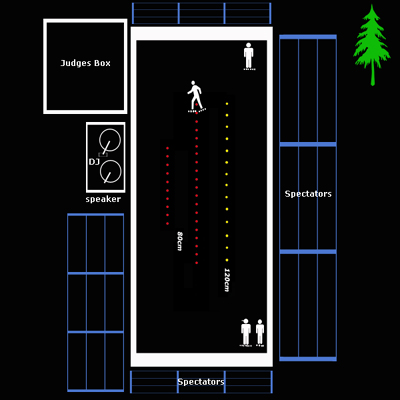4/Composition
of groups
If
there is enough time and depending on the wishes of the
organisation, a qualification round should be organised.
If the time is too tight, the groups can be sorted by the
judges team.
A/Qualifications
Before
the battle groups competition, each skater has to do one
individual run of 30sec to 60sec in order to make a ranking.
The groups will be made depending on this ranking like following
:

B/Sort
If the qualification
run is not possible, the groups are sorted by the judge
team before the battle competition. If top skaters are identified
in the entry list, they shouldn't be in the same group in
the first rounds. The sort will be done in the following
way : each skater has a battle number, every top skaters
number is in the same box, a second box contain the battle
group number. For example : 14 skaters, 3 top skaters (n°1,2,3),
4 battle groups, 4 skaters maximum in each group. The first
sort is done with the top skaters, two boxes, one with the
skaters numbers, another with the group numbers, the judge
take one number in the first box, then another one in the
second box, and do again 2 more times. Each top skater is
now in a different group. In this example, one number will
be left (group 2), the judges will add to this number the
other group numbers left (3 for each group). Then they put
the numbers of the other skaters in the first box and sort
them until everybody is placed in a group. In this example,
two groups are composed by 3 skaters only.

4/Judges
-At least
3 judges are needed + 1 speaker (chronometer judge) + at
least 1 cone boy.
1/Run
Judges : Each judge evaluate each skater of the
battle group according to the different criteria like style,
technique, mistakes, new tricks, ... After each group, they
make a ranking of the skaters of the group and decide who
will go to the next round.
A point system
may be elaborated soon to help judges to evaluate the skaters...
3/
Speaker : The speaker has a key role in the competitions.
The speaker manages the time of the runs and of the groups,
he also presents each skater of the group and does animation
of the battles.
2/
Cone boys : They have to take the cones hit and
put them back on the marks. They do it
only when the skater has left the line where the cones were
hit. They have to be very fast and never stand between the
judges & the skater.
5/Judgment
In a Battle
group, each skater has several runs, each run is evaluated
by the judges, They give a mark on 10/20 points for each
run. At the end of the battle group, they make totals and
do the ranking. The mark is given on technical and style
parameters --% is based on technical features (difficulty
of tricks, average speed of the tricks), --% is based on
style features (ease of the tricks, personnal style of the
skater, originality of tricks). A bonus can be given for
risks taken during the runs.
If a skater
hits cones during one trick or trick sequence, he can start
again until the time of the run is finished. During a trick
or trick sequence, if a skater hits 3 cones or more, the
judges won't count the sequence or the trick.

Categories
In a Battle
competition, different categories can be opened depending
on the numbers of competitors of this category or the wishes
of the organisation.
Men Pro /
Amateurs / beginners, Women Pro / Amateurs / Beginners
To participate
in the "Pro" category, skaters have to win at
least one "Amateur" competition, or to have a
white card from the competition organisation. final amateur-->pro
rounds.
Requirements
Place : from
3m x 26m or larger. Flat surface without holes, bumps, etc...
Grippy and smooth surface. it may be asphalt, concrete,
wood, pavement, ...
One Dj, One
speaker, Three to Five judges, one or two cone boys/girls.
Prizes :
Material or Money at least for 10 firsts (Pros), 5. firsts
(Am) (consolation final & final)
|

